The Samsung Galaxy Tab S2 Review
by Brandon Chester on October 15, 2015 8:00 AM ESTSystem Performance: GPU
While CPU performance characterizes one part of an SoC, GPU performance characterizes another. Tablets have long been a form factor where GPU performance can be pushed much further than in a phone due to the larger chassis of a tablet having far fewer size and thermal limitations. While some tablets elect to use specialized SoCs with more powerful GPU hardware than smartphones, the Tab S2 uses the same ARM Mali T760 GPU used in the Galaxy Note 4 Exynos.
To characterize the Tab S2's GPU performance I've run it through our standard GPU benchmarks. First up is 3DMark which actually has both a CPU and GPU component, followed by BaseMark X and GFXBench which focus more strongly on the GPU alone.
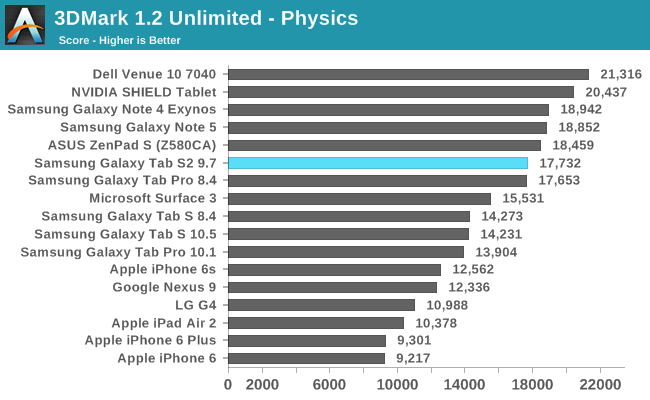


In 3DMark all of the Tab S2's scores are roughly equivalent to the Galaxy Note 4 Exynos which is not unexpected. Unfortunately, it's clear that Mali T760 can't keep up with NVIDIA's mobile Kepler implementation or Apple's custom 8 core PowerVR 6XT part. While the Nexus 9 and iPad Air 2 both fall short in the physics sub test their scores in the graphics sub test are in a completely different league than the Tab S2.
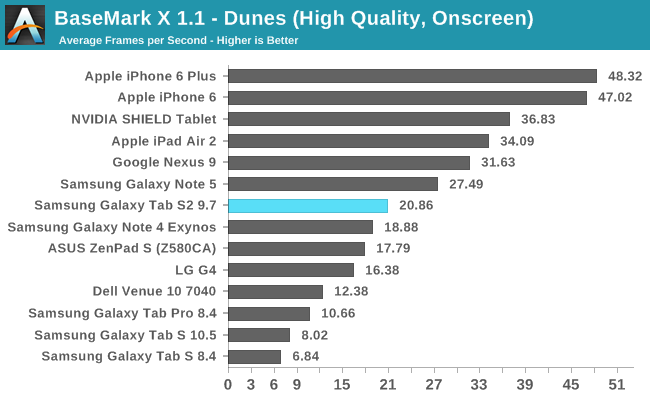
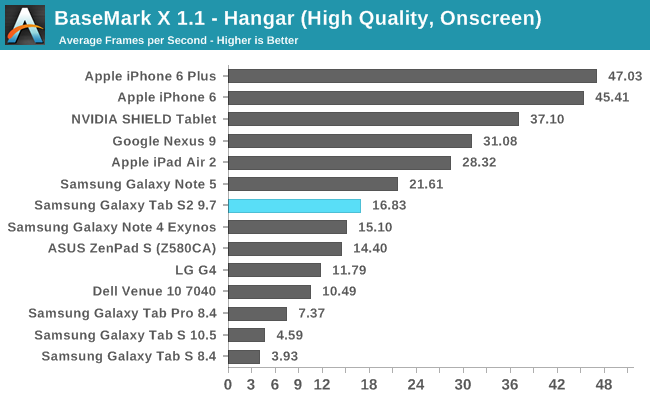
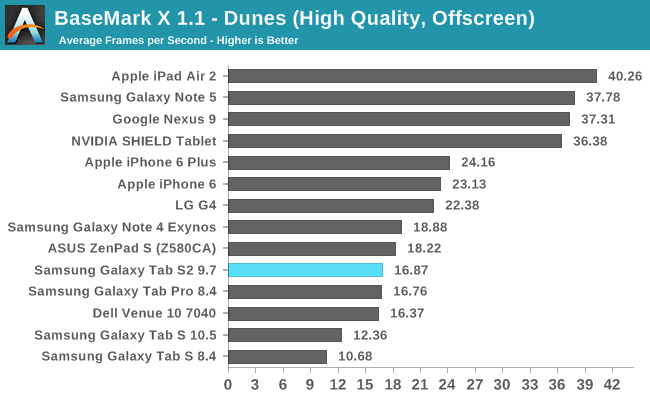
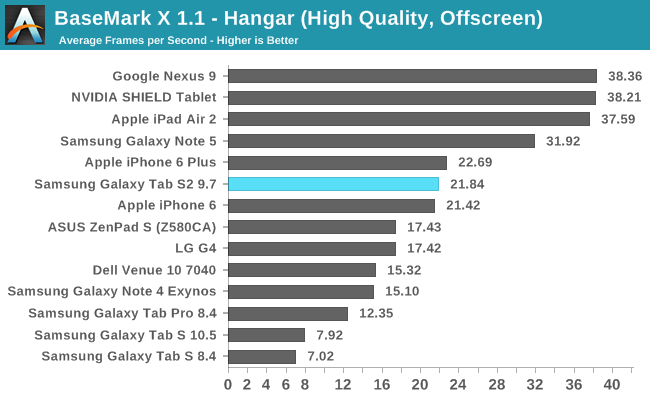
In BaseMark X we again see the Tab S2 sitting fairly far behind the iPad Air 2 and Nexus 9. If I was considering the Tab S2 8.0 which retails for $399 these results would be perfectly fine, as the major competition at that price point is the iPad Mini 4 which has Apple A8 SoC. At $499 the GPU performance simply isn't competitive, and it outlines the issues with trying to make one SoC fit many different devices.
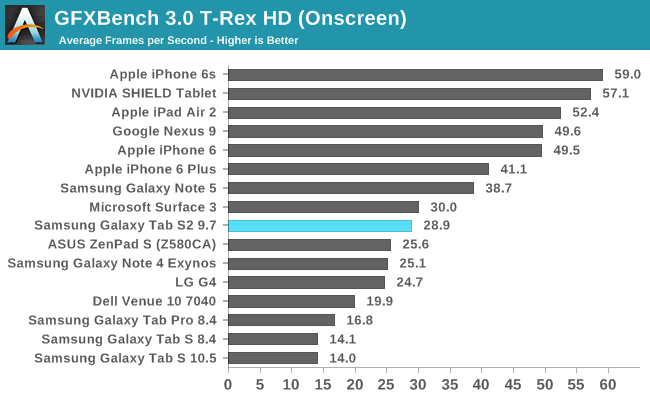
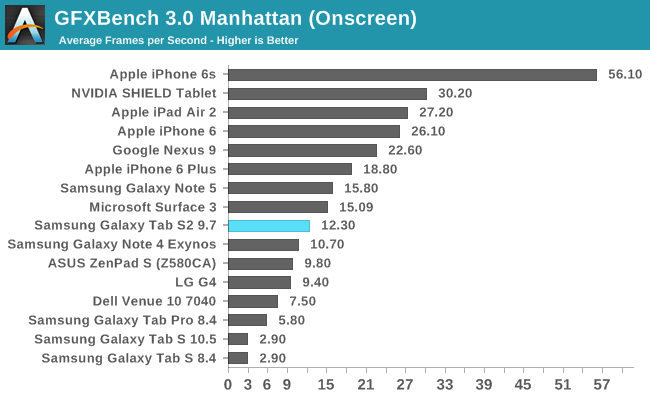
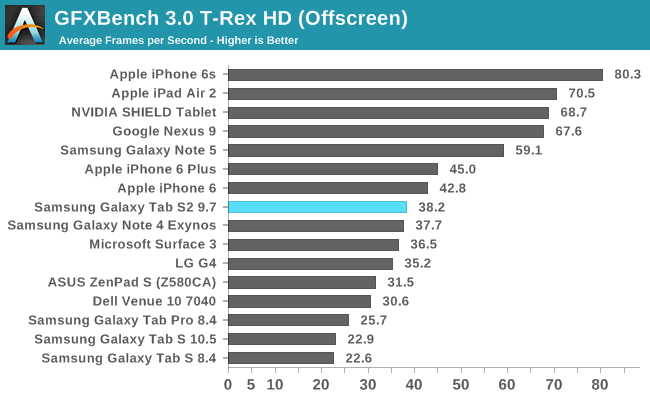
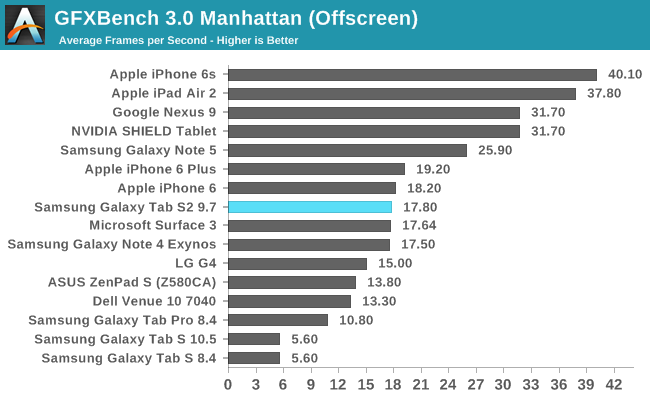
In GFXBench the Tab S2 is in the same situation as the previous tests. GPU performance is right around where the Galaxy Note 4 and iPhone 6 are, and it's just not good enough to justify the $499 price tag of the Tab S2.
Like I said on the last page, the fact that most Android tablet OEMs aren't providing CPU and GPU performance that is anywhere near competitive with the iPad Air 2 is a very bad thing for the entire tablet industry. Apple decided to not even update the iPad Air 2 despite it being a year old, and it's hard to blame them when nobody is close to them as far as performance is concerned. Having various manufacturers pushing each other to constantly improve is one of the primary drivers behind the advancements made in the mobile space, and I'm concerned that this no longer exists in the tablet market as the only tablets that come close are ones with NVIDIA's SoCs which also happen to be tablets that don't ship in very great volume.
System Performance: NAND
While it's still not advertised in specifications like on laptops, a mobile device's internal storage is now being recognized as a highly relevant part of overall system performance. Internal eMMC NAND solutions have traditionally had very poor storage performance, and different vendors have done different things to address the problem.
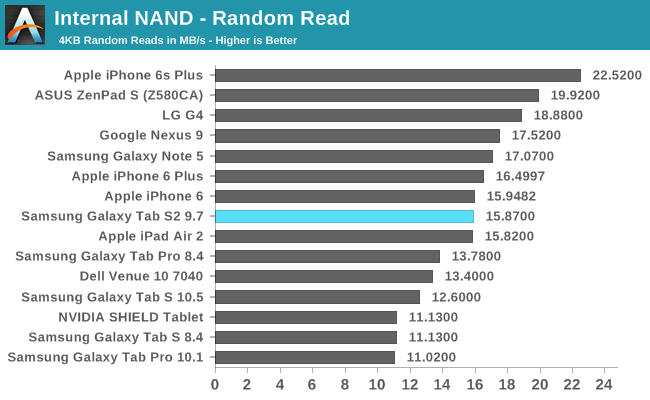
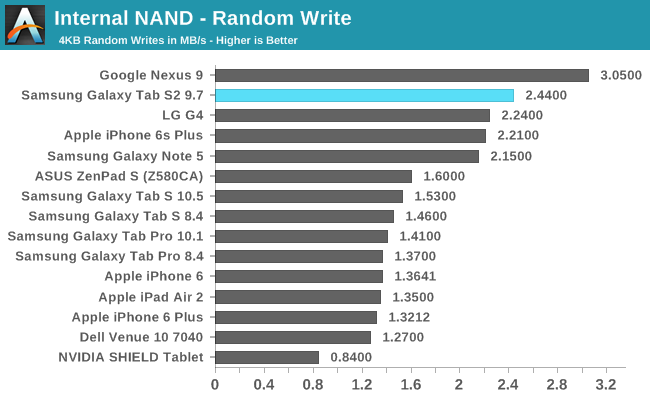
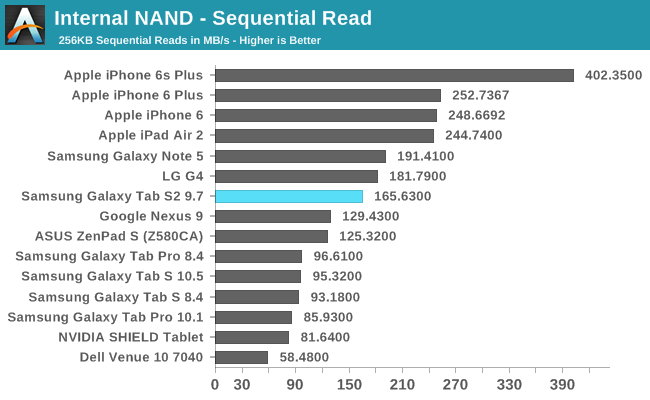
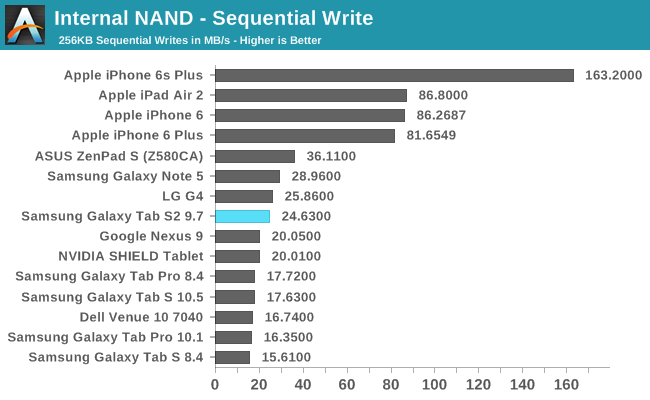
Both sets of read and write results are right around what you'd expect. Random writes in particular are very fast, and all the other results are fairly similar to those of the Galaxy Note 5. I don't expect internal NAND speeds will be a bottleneck on the Galaxy Tab S2, which is expected and fitting of a flagship tablet.










162 Comments
View All Comments
osxandwindows - Thursday, October 15, 2015 - link
@FlyBriWhat if you could get an iPad screen on an iPhone?
lilmoe - Thursday, October 15, 2015 - link
You have all the right to disagree. These are only opinions, Yours and mine. These opinions might be very different from Samsung's research and design decisions. I've simply stated a *possibility* for their alleged "compromise(s)". Who knows, Samsung probably decided to skip the 7420 because of low yield, and they prioritized their flagship smartphones over their tablets.That said, liking the iPad's LCD has nothing to do with the price difference. AMOLED is still more expensive to manufacture. I would argue that OLED is generally more appealing to consumers and more pleasing to the eyes. Samsung's AMOLED has drastically improved the past couple of years. According to my own experience, people just love the "pop"... And those who prefer color accuracy are also well served by the current generation of AMOLED.
ARM tablets are no longer the mainstream "must haves". Most people don't even use them anymore. Samsung, Apple and other manufacturers are researching the needs for specific niche consumers at this point.
For those who do, I really hardly see anyone using an ARM tablet outside of social media, browsing, watching video. Maybe a magazine here and there, but nothing else. I completely disagree that tablet users who play high-end games are any sort of majority. High end, or AAA, gaming is usually exclusive for consoles and PCs. Most tablet users play less resource intensive, casual games. Besides, there aren't even that many titles (if any) in the Play Store than can saturate the Exynos 5433, let alone Apple's A8X (most tablets sold are NOT iPad Air 2s... and game developers target lower specs for iOS). The Exynos 5433 is more than capable of running titles like Asphalt 8 and Dead Trigger just fine.
Also, tablets are used a LOT less than smartphones. Therefore, one might argue that longer battery life isn't as important as thinner, lighter profiles for current tablet consumers.
nerd1 - Thursday, October 15, 2015 - link
Check BOM of iPhones and galaxy phones. AMOLED screen are usually 3x the price of LCDs.And what can you do with that 'powerful' AP anyway? Running dumbed down mobile browser? Running crappy phone games? Playing 8K video on 2K screen?
zepi - Thursday, October 15, 2015 - link
Tablets are an odd market. People mostly seem to use them for web browsing and video viewing, where performance doesn't really matter that much. Reason is unknown. Maybe it is the matter of apps not existing for other tasks. Or maybe tablet form factor just doesn't work with anything else.I guess that mostly because of this, Android makers try to get away with putting cheap and "slow" SOC's into their tablets.
Apple hit the same issue when it was noticed that iPad sales was way slower than expected. It seems that upgrade cycles are much longer, since simple performance bumps just didn't seem to matter and there are no 24month phone-contracts like with the phones to push sales. This has obviously led to Apple's current push towards trying to transform tablet market by making iPad Air 2 & iPad Pro and putting emphasis behind the productivity use with the hopes of pushing the market towards something more than just content consumption.
MS seems to be pushing for the same thing with Surfaces, though they are coming from the desktop direction when Apple is approaching this market from mobile device direction.
Android makers... Well, as can be seen here, Samsung can only do so much with the multitasking and productivity features and Google has been quite ignorant towards pushing tablets forwards.
FlyBri - Thursday, October 15, 2015 - link
@zepi I would agree that most people use tablets for web browsing and video (probably more so for web browsing), which is why Samsung went with a 4:3 aspect ratio on the Tab S2. Since they did that, they lost their differentiating factor with the iPad. Because of this, they really needed to step it up to compete, and they pretty much failed on that front. The Tab S2 is significantly slower and gets much worse web browsing battery life than the Air 2, and the Air 2 is a year old. I have no problem with Samsung releasing the Tab S2, but it's very clear it's overpriced. For what it is and what it can do, it's a $300-350 tablet in today's market, not $500.osxandwindows - Thursday, October 15, 2015 - link
You can't really use surface touch screen for productivity, There is simply no windows productivity apps for tablet.The iPad pro is not going to fail like most people say.
The iPad pro has one advantage over the surface and that is the App Store.
zepi - Thursday, October 15, 2015 - link
It remains to be seen. Personally my guess is that both will have their supporters and both will "stay alive".osxandwindows - Thursday, October 15, 2015 - link
@zepiIts not that I don't like the concept behind the surface pro or surface book.
Its just that I don't see the use of a touch screen that can be removed.
Media consumption?, with 3 hours of battery life when removed?, I wood rather buy an iPad for that.
blackcrayon - Thursday, October 15, 2015 - link
Yeah at that point, why not have a nice laptop and a decent tablet on the side, you can even use them together for some tasks.osxandwindows - Thursday, October 15, 2015 - link
If you have a mac and an iPad pro, You will have the perfect combination.Apples continuity is pretty much like a surface use case.
Plus with lightning flash drives you will be able to save 4k video.